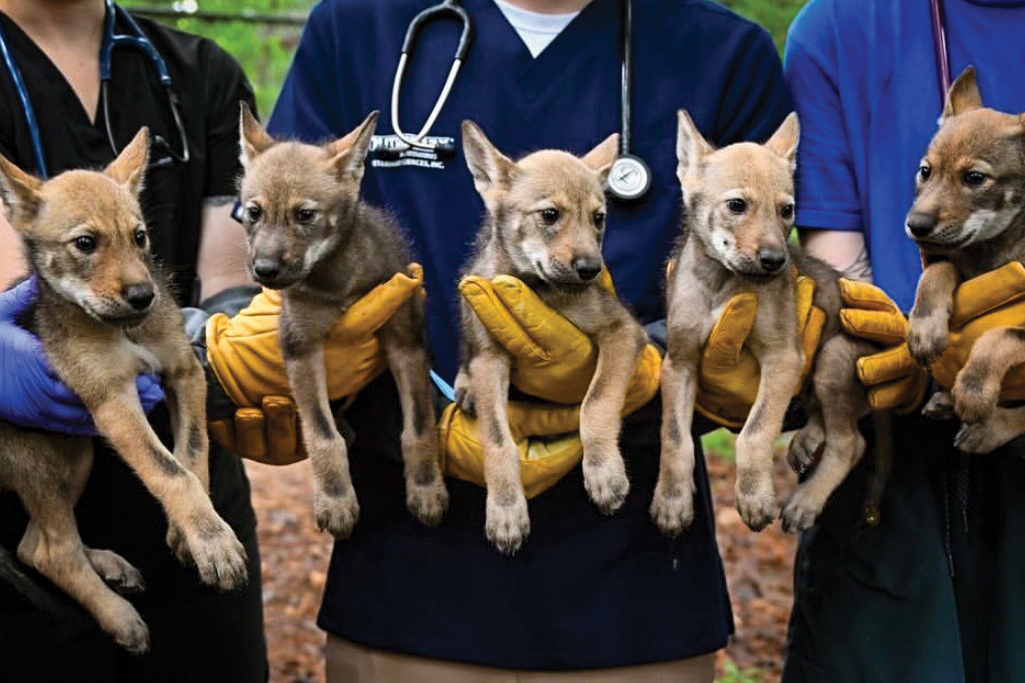The red wolf, a species native to the southeastern United States, continues to recover from the brink of extinction with the help of conservation programs across the country. At NC State, a unique effort involving veterinary students, faculty and partnerships with federal wildlife agencies is playing a critical role in their recovery.
This year has been a landmark one for red wolves in the wild and under human care, also known as the “SAFE” population, with a larger-than-usual litter born and notable successes in treating injured wild wolves on campus.
Caroline Diehl, a third-year master’s of veterinary medicine student and president of the Carnivore Conservation Crew, a student organization that cares for NC State’s red wolf population, said caring for this year’s on-campus litter has been a different experience from last year’s.
“Last year we had two, so it was a little bit more manageable to learn the ropes, which helped,” said Dr. Tara Harrison, faculty advisor of the Carnivore Conservation Crew and professor of veterinary medicine. “This year we have five. So that’s been really fun to navigate having so many.”
The puppies were born a little after Mother’s Day in late spring, and now, several months old, Diehl said they look like smaller versions of adult red wolves, still growing into their ears and paws. The puppies join their two older siblings, who were born last year, and their parents in NC State’s largest red wolf pack.
Dr. Harrison said the team manages their care with minimal human contact to avoid habituating the animals, since these wolves have the potential to be released back into the wild, either as fosters, where newborn pups are placed in wild wolf dens, or as adults; both increasing the genetic variety of the red wolf population.
“We don’t do any hand-rearing,” Harrison said. “Mom does all the work. We only vaccinate them or provide medical care as needed.”
Red wolves are among the most endangered animals on the planet, with only an estimated 28 to 31 individuals living in the wild and less than 300 in managed care across the country. Years of habitat loss, hunting and hybridization with coyotes have pushed the species to the brink, making every birth vital to their survival. After periods where no pups survived and populations plummeted, this year’s litter at NC State is a significant milestone for red wolf recovery.
“This year stands out because it is the most pups born, the most litters, the most breeding pairs we’ve had in over a decade,” said Joe Madison, North Carolina program manager for the Red Wolf recovery program with the U.S. Fish and Wildlife Service. “So yes, this was a stellar year.”
Madison said the partnership between NC State and the U.S. Fish and Wildlife Service is especially crucial to the red wolf program. Madison emphasized the importance of the University within the SAFE population management program that coordinates red wolves across 52 zoos and wildlife centers in the US.
“The SAFE program, of which NC State is part of, is our largest partner, of course, so much of what we do could not be possible without that partnership, ” Madison said. “ … NC State, specifically because of what they bring to the table, we have a closer collaboration partnership with them than most of the SAFE organizations.”
NC State provides veterinary care for injured wild red wolves that cannot be fully treated in the field. Madison described one case of a wild female red wolf severely injured by a bite, which turned infected and was treated at NC State. Once released back into the wild earlier this year, she had a litter of her own.
“What would have likely been a mortality has turned into an additional breeding pair and family group that actually had pups out there,” Madison said.
Diehl said caring for this wild, injured wolf was challenging but one of the most rewarding opportunities she’s experienced, inspiring her and her teammates.
“She ended up having successful puppies this year, which was so unbelievably rewarding to kind of see all the effort we put in really make such a big impact,” Diehl said. “I mean, we were doing treatments several times a week where we would have to get hands on her and actually maintain the injury that she had. And so to be able to have such an amazing success story, I think, was a huge propelling force to kind of keep the momentum going.”
The program gives students hands-on experience in conservation medicine specialized for red wolves, which differs from domestic animal care. Veterinary faculty mentor students in managing the health of the captive wolves while preparing them for potential release.
Diehl noted the unique educational opportunities within the program.
“We are the only vet school in the country that has red wolves at all,” Diehl said. “You learn firsthand about conservation medicine, thinking not only about individual health but about maintaining a population.”
Despite the recent instability of the red wolf population, Madison said the wolves are resilient and vital to ecosystem health.
“They really help create healthier ecosystems,” Madison said, adding that red wolves are secretive animals that tend to avoid human contact. Conservation outreach in rural North Carolina requires coexistence with landowners.
Madison said the partnership is far from limited to veterinary medicine. Every year, students meet with Madison and his team to exchange research and information on both the wild and SAFE red wolf populations, ranging from ecological studies to improving captive management protocols.
NC State’s contributions also include students tackling threats like vehicle strikes. Madison said engineering students have been developing radio collars that will detect the presence of red wolves and alert drivers when they are nearby.
The Carnivore Conservation Crew was featured in a segment of The Today Show in April, which Diehl said was likely driven by the puppies and their public appeal.
“They had reached out to us about wanting to do a story, and then the puppies, I would say, were the biggest kind of driving force, in terms of the ability to draw in the public, and the growth was pretty exponential,” Diehl said.
Diehl said she is inspired by the red wolves, witnessing firsthand how much they can endure and still survive against the odds.
“Just on an animal level, to be able to see what they can overcome, how they can survive — and I mean, their populations dwindled to almost nothing, and they’ve been able to come back to the degree that they have,” Diehl said. “It’s nowhere near what it would be in an ideal situation, but it’s grown so, so much, and I think that speaks not only to the people’s effort on an individual level, but also it’s the animal’s ability to persevere.”





